trailer AUDI S6 2016 User Guide
[x] Cancel search | Manufacturer: AUDI, Model Year: 2016, Model line: S6, Model: AUDI S6 2016Pages: 294, PDF Size: 73.88 MB
Page 126 of 294
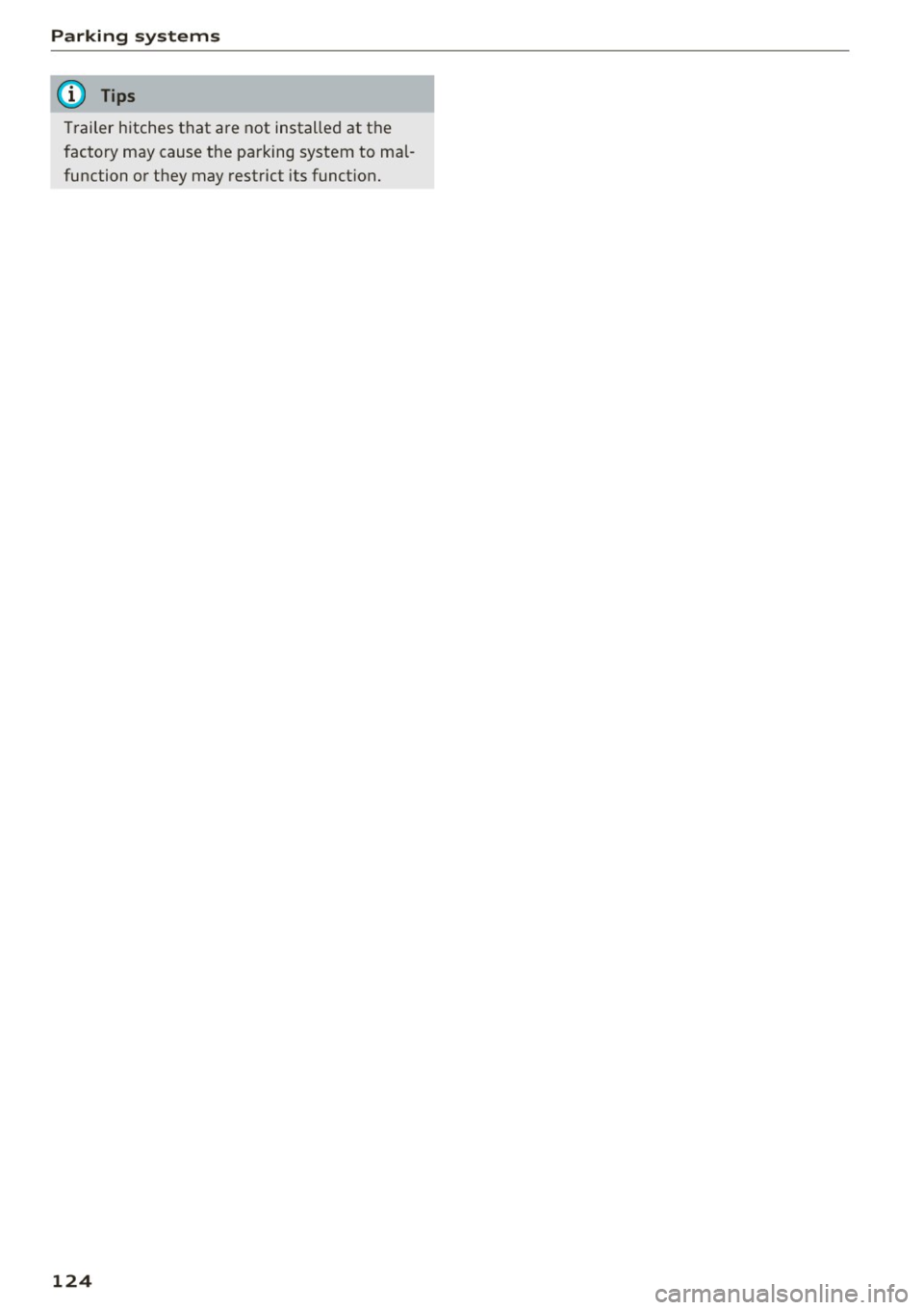
Parking sy stem s
(D Tips
Trailer hitches that are not installed at the
factory may cause the parking system to mal
function or they may restrict its funct ion.
124
Page 201 of 294
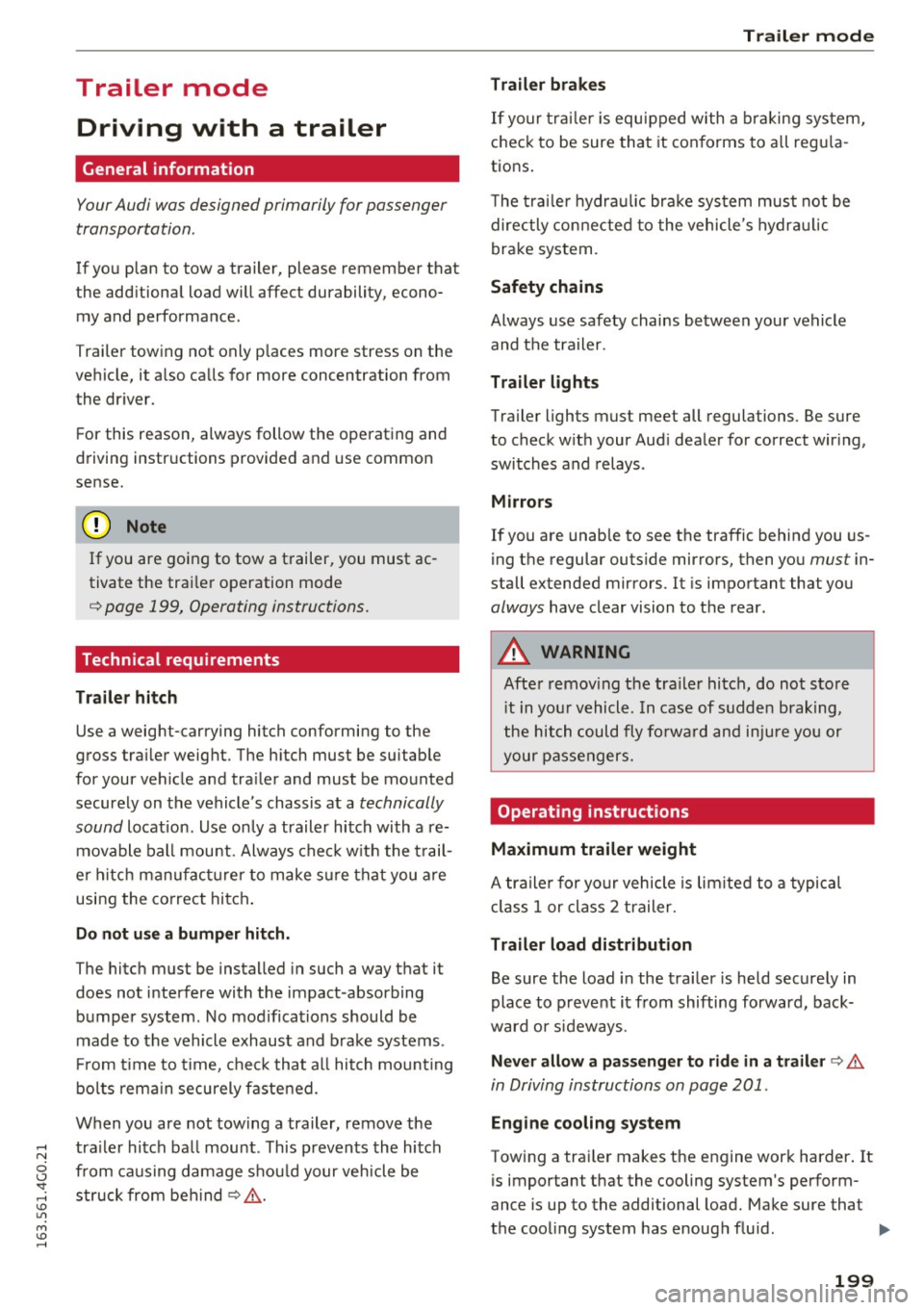
Trailer mode Driving with a trailer
General information
Your Audi was designed primarily for passenger
transportation .
If you plan to tow a trailer, please remember that
the additional load will affect durability, econo
my and performance.
T railer tow ing not only p laces more stress on the
vehicle, it a lso calls for more concentration from
the dr iver.
F or this reason, always follow the operating and
driving instructions provided and use common
sense.
(D Note
If you are going to tow a trailer, you must ac
tivate the trai ler operation mode
¢ page 199, Operating instructions.
Technical requirements
Tr ailer hitch
Use a weight -carrying hitch conforming to the
gross tra iler weight. The h itch must be suitab le
for your vehicle and tra ile r and must be mo unted
securely on the vehicle's chassis at a
technically
sound
location . Use on ly a trailer hitch with a re
movable ba ll mou nt. Always che ck wit h the t rail
e r hitch manufac turer to make s ure that you a re
usi ng the co rrect hitch .
Do not use a bumper hitch .
The hitch must be installed in such a way that it
does not interfere with the impact -absorbing
bumper system . No mod ifica tions should be
made to the vehicle exhaust and brake systems .
Fr om time to time, chec k that all hitch mo un ting
bo lts rem ain securely fastened.
W hen you are not tow ing a trailer,
remove the
tra iler hitch ba ll mount . This prevents the hitch
from ca u sing damage s hou ld your veh icle be
struck from behind
¢ .&, .
Trailer mode
Trailer brakes
If your traile r i s equ ipped with a b raking sys tem,
c h ec k t o be sure that it con forms to a ll regu la
tions.
T he tra ile r h ydr aulic bra ke sy stem must not be
directly con nected to the vehicle's hydr aulic
brake sy stem.
Safety chains
Always use safety chains between your vehicle
and the tra iler .
Trailer lights
Trailer lights must meet all regulations. Be sure
to check w it h your Aud i dealer for correct wir ing,
swi tches and relays .
Mirrors
If you are unab le to see the traffic behind you us
ing the regular outside mirrors, then you
must in
stall extended mirrors . It is important that you
always have clear vision to the rear .
A WARNING
--
After remov ing the tra ile r hi tch, do not sto re
i t in yo ur vehicle. In case of sudde n brak ing,
t he hitch could fly fo rwa rd and injure you or
your passengers.
Operating instructions
Maximum trailer weight
A traile r for yo ur vehicle is lim ited to a typical
cla ss 1 or class 2 trailer.
Trailer load distribut ion
Be sure the load in the tra iler is held secure ly in
place to p reve nt it from shifting forward, back
ward o r sideways.
Ne ver allow a passenger to ride in a trailer¢.&.
in Driving instructions on page 201 .
Engine cooling system
Towing a tra ile r makes the engine wor k harder. It
is important that the cooling system's perform
ance is up to the additional load. Make sure that
the cool ing system has enoug h fluid . .,..
199
Page 202 of 294
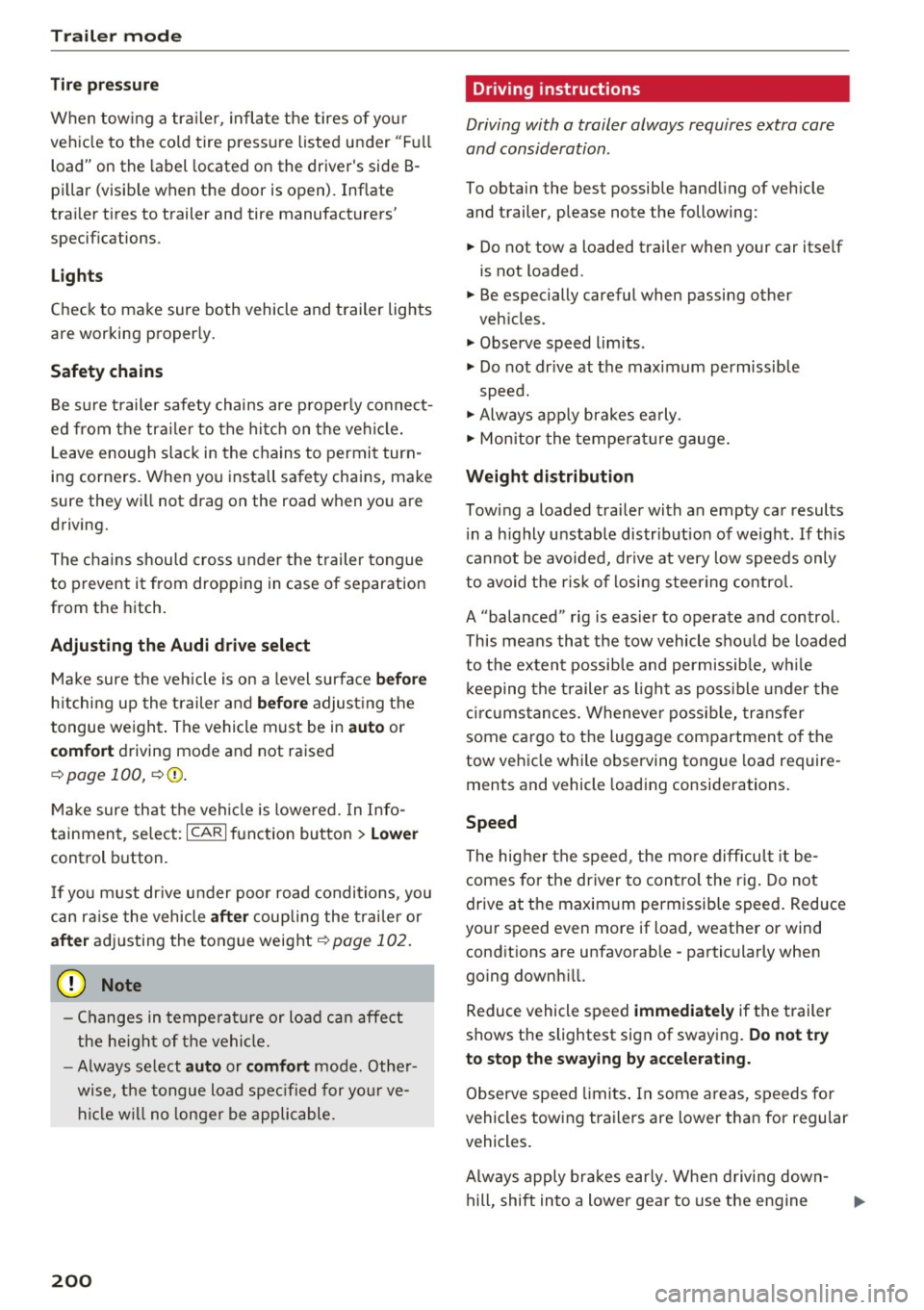
Trailer mod e
Tire pr essure
When tow ing a tra iler, inflate the tires of you r
veh icle to the cold tire pressure listed under "Fu ll
load" on the label located on the driver's side B
pillar (visib le when the door is open) . Inflate
trai ler tires to trailer and tire manufacturers'
specifications.
Light s
Check to make sure both vehicle and trailer lights
are working proper ly.
Safet y chains
Be sure t railer safety chains are properly connect
ed from the trailer to the h itch on the veh icle.
L eave enough slack in the chains to permit turn
ing corners . When yo u install safety chains, make
sure they wi ll not drag on the road when you are
driving.
The chains shou ld cross under the trailer tongue
to prevent it from dropping in case of separation
from the hitch .
Adjusting the Audi d rive select
Make sure the vehicle is on a level surface bef ore
hitching up the t railer and bef ore adjust ing the
tongue we ight . The vehicle must be in
auto or
comf ort driving mode and not raised
r::!> page 100, r::!> 0 .
Make sure that the vehicle is lowered. In Info
tainment, select:
ICARI function button > Lower
control button .
I f you m ust dr ive under poor road condit ions, you
can ra ise the vehicle
afte r coup ling the t rai ler or
after adjusting the tongue weight r:!> page 102.
(D Note
-Changes in tempe rature or load can affect
the he ight of the vehicle.
- Always se lect
auto or comfort mode. Othe r
wise, the tongue load spec ified for yo ur ve
hicle w ill no longer be applicable .
200
· Driving instructions
Driving with a trailer always requires extra care
and consideration .
To obtain the best possible hand ling of veh icle
and trailer, please note the following:
.,. Do not tow a loaded trailer when your car itself
is not loaded .
.,. Be especially careful when passing other
vehicles .
.,. Observe speed limits .
.,. Do not dr ive at the maximum permissible
speed.
.,. Always app ly brakes ea rly.
.,. Monitor the temperat ure gauge.
Weight distribution
Towing a loaded trai ler with an empty car results
i n a h ighly unstab le distribution of weight . If this
cannot be avoided, drive at very low speeds only
to avoid the risk of losing steer ing contro l.
A "balanced" rig is easier to operate and control.
This means that the tow vehicle shou ld be loaded
to the extent possible and permissib le, wh ile
k eeping the trailer as l ight as poss ible under the
c ircu mstances . Wheneve r possib le, transfer
some ca rgo to the luggage compartment of the
tow vehicle while observing tongue load require
ments and vehicle loading considerations.
Speed
The higher the speed, the mo re diff icu lt i t be
comes fo r the driver to con trol the r ig . Do not
drive at the maximum permissible speed. Reduce
your speed even more if load, weather or wind
cond itions are unfavorab le -particularly when
go ing downh ill.
Reduce vehicle speed
i mmed iatel y if the trailer
shows the slightest sign of swaying.
Do not tr y
to stop the swaying by accelerating.
Observe speed limits . In some areas, speeds for
vehicles towing trailers are lower than for regular
vehicles .
Always apply bra kes early. Whe n driving down -
hill, shift into a lower gear to use the engine .,..
Page 203 of 294
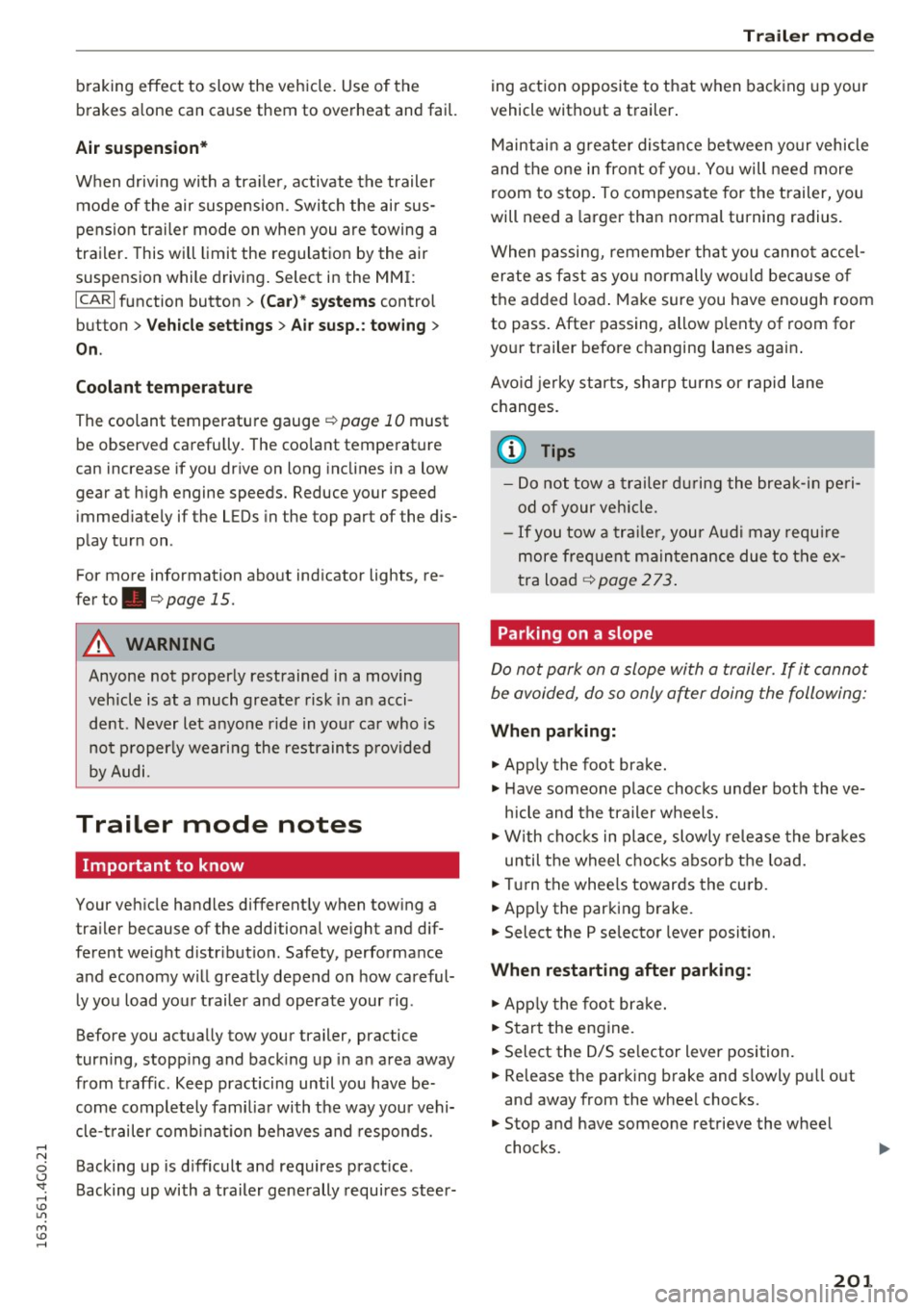
braking effect to slow the vehicle. Use of the
brakes alone can cause them to overheat and fail.
Air suspension*
When driving with a tra ile r, activate the trailer
mode of the air suspension. Switch the air sus
pension trailer mode on when you are towing a
trailer. This will limit the regulation by the air
suspension while driving. Select in the MMI :
ICARI function button > (Car)* systems control
button>
Vehicle settings> Air susp.: towing>
On.
Coolant temperature
The coolant temperature gauge¢ page 10 must
be observed carefully . The coolant temperature
can increase if you drive on long inclines in a low
gear at high engine speeds. Reduce your speed immediately if the LEDs in the top part of the dis
play turn on .
For more information about ind icator lights, re
fer to. ¢
page 15.
A WARNING
Anyone not properly restrained in a moving
vehicle is at a much greater risk in an acci
dent. Never let anyone ride in your car who is
not p roperly wearing the restraints p rovided
by Audi.
Trailer mode notes
Important to know -
Your vehicle handles differently when towing a
trailer because of the additional weight and dif
ferent weight distribution. Safety, performance
and
economy will greatly depend on how careful
ly you load your trailer and operate your rig .
Before you actually tow your trailer, practice
turning, stopping and backing up in an area away
from traff ic. Keep practicing until you have be
come comp letely fami liar with the way your vehi
cle-trailer comb inat ion behaves and responds.
Backing up is difficult and requires practice.
Backing up with a trailer generally requires steer-
Trailer mode
ing action opposite to that when backing up your
vehicle without a trailer .
Maintain a greater distance between your vehicle
and the one in front of you. You will need more
room to stop . To compensate for the trailer, you
will need a larger than normal turning radius .
When passing, remember that you cannot accel
erate as fast as you normally wo uld because of
the added load . Make sure you have enough room
to pass. After passing, allow p lenty of room for
your trailer before changing lanes again .
Avo id jerky starts, sharp turns or rapid lane
changes.
(D Tips
- Do not tow a trailer during the break-in peri
od of your veh icle.
-If you tow a trailer, your Audi may require
more frequent maintenance due to the ex
tra load ¢
page 2 73.
Parking on a slope
Do not pork on a slope with a trailer. If it cannot
be avoided, do so only ofter doing the following:
When parking:
"Apply the foot brake .
" Have someone place chocks under both the ve
hicle and the trailer wheels.
"W ith chocks in place, slowly release the brakes
until the wheel chocks absorb the load.
" Turn the whee ls towards the curb.
" App ly the parking brake.
" Select the P selector lever position.
When restarting after parking:
"App ly the foot brake.
" Start the engine .
"S elect the D/S se lector lever position.
" Release the parking brake and slowly pull out
and away from the wheel chocks.
" Stop and have someone retrieve the wheel
chocks.
201
Page 204 of 294
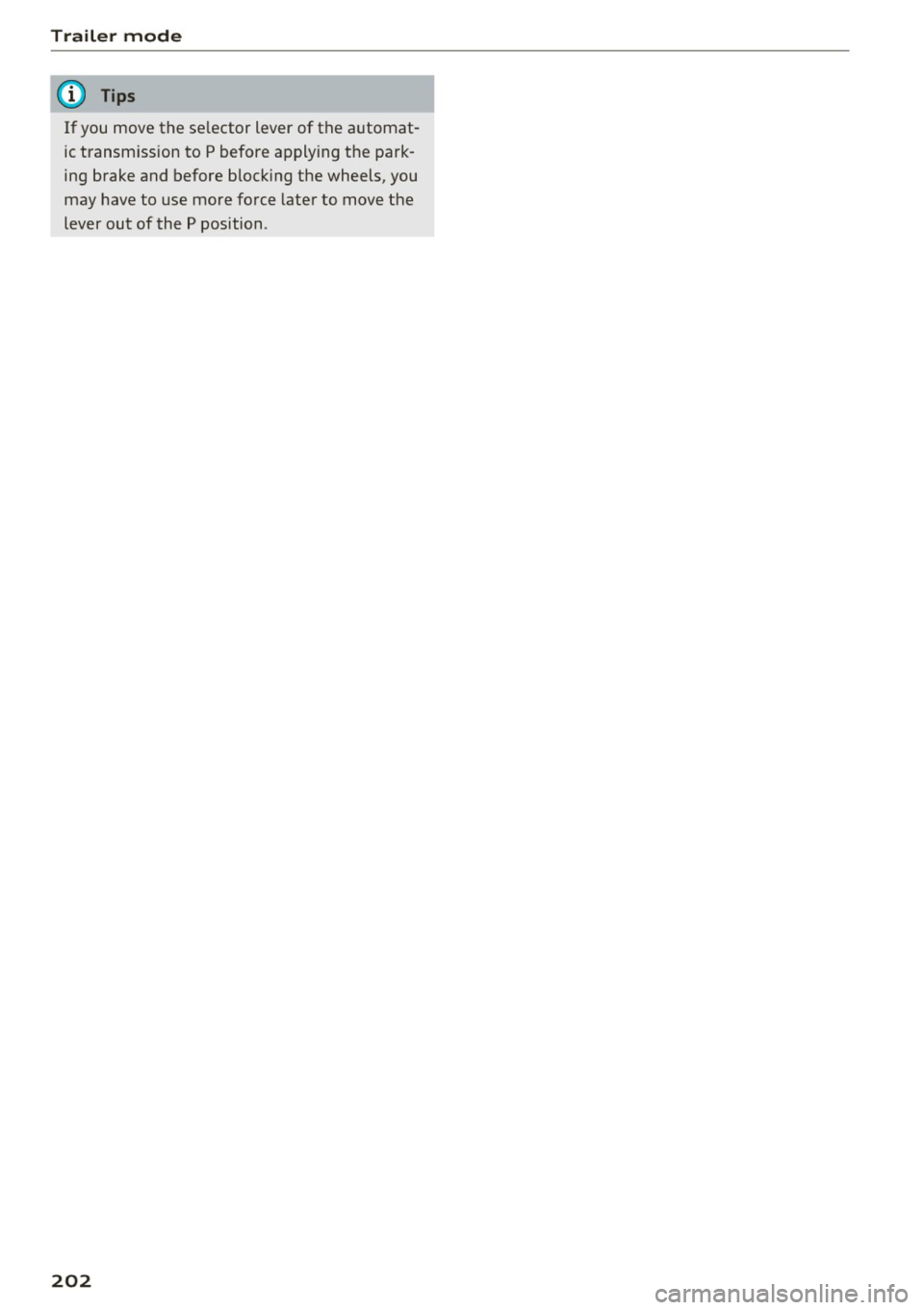
Trailer mod e
(D Tips
If you move the se lector lever of the automat
ic transm ission to P before applying the park
ing brake and before block ing the wheels, you
may have to use more force later to move the
lever out of the P position .
202
Page 246 of 294
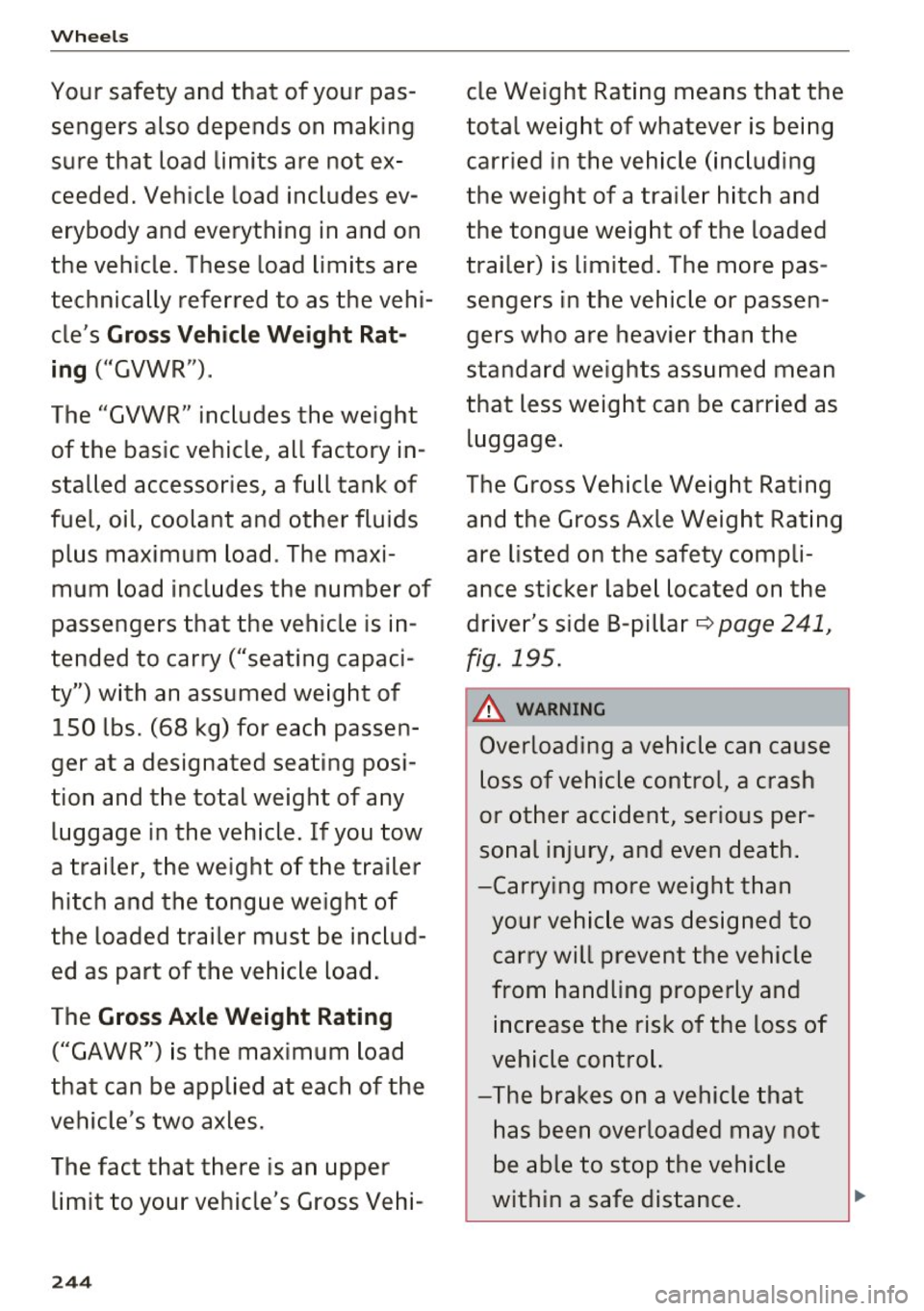
Wheels
Your safety and that of your pas
sengers also depends on making
sure that load limits are not ex
ceeded. Vehicle load includes ev
erybody and everything in and on
the vehicle. These load limits are
technically referred to as the vehi
cle's
Gross Vehicle Weight Rat
ing
("GVWR") .
The "GVWR" includes the weight of the basic vehicle, all factory in
stalled accessories, a full tank of
fuel, oil, coolant and other fluids
plus maximum load . The maxi
mum load includes the number of
passengers that the vehicle is in
tended to carry ("seating capaci
ty") with an assumed weight of 1 SO lbs. (68 kg) for each passen
ger at a designated seating posi
tion and the total weight of any
luggage in the vehicle. If you tow
a trailer, the weight of the trailer hitch and the tongue weight of
the loaded trailer must be includ
ed as part of the vehicle load.
The
Gross Axle Weight Rating
("GAWR") is the maximum load
that can be applied at each of the
vehicle's two axles.
The fact that there is an upper limit to your vehicle's Gross Vehi-
244
cle Weight Rating means that the
total weight of whatever is being carried in the vehicle (including
the weight of a trailer hitch and
the tongue weight of the loaded
trailer) is limited. The more pas
sengers in the vehicle or passen
gers who are heavier than the
standard weights assumed mean
that less weight can be carried as
luggage.
The Gross Vehicle Weight Rating
and the Gross Axle Weight Rating
are listed on the safety compli
ance sticker label located on the
driver's side B-pillar
¢ page 241,
fig. 195.
&_ WARNING ~
Overloading a vehicle can cause
loss of vehicle control, a crash
or other accident, serious per
sonal injury, and even death.
-Carrying more weight than your vehicle was designed to carry will prevent the vehicle
from handling properly and increase the risk of the loss of
vehicle control.
-The brakes on a vehicle that has been overloaded may not
be able to stop the vehicle
within a safe distance.
Page 247 of 294
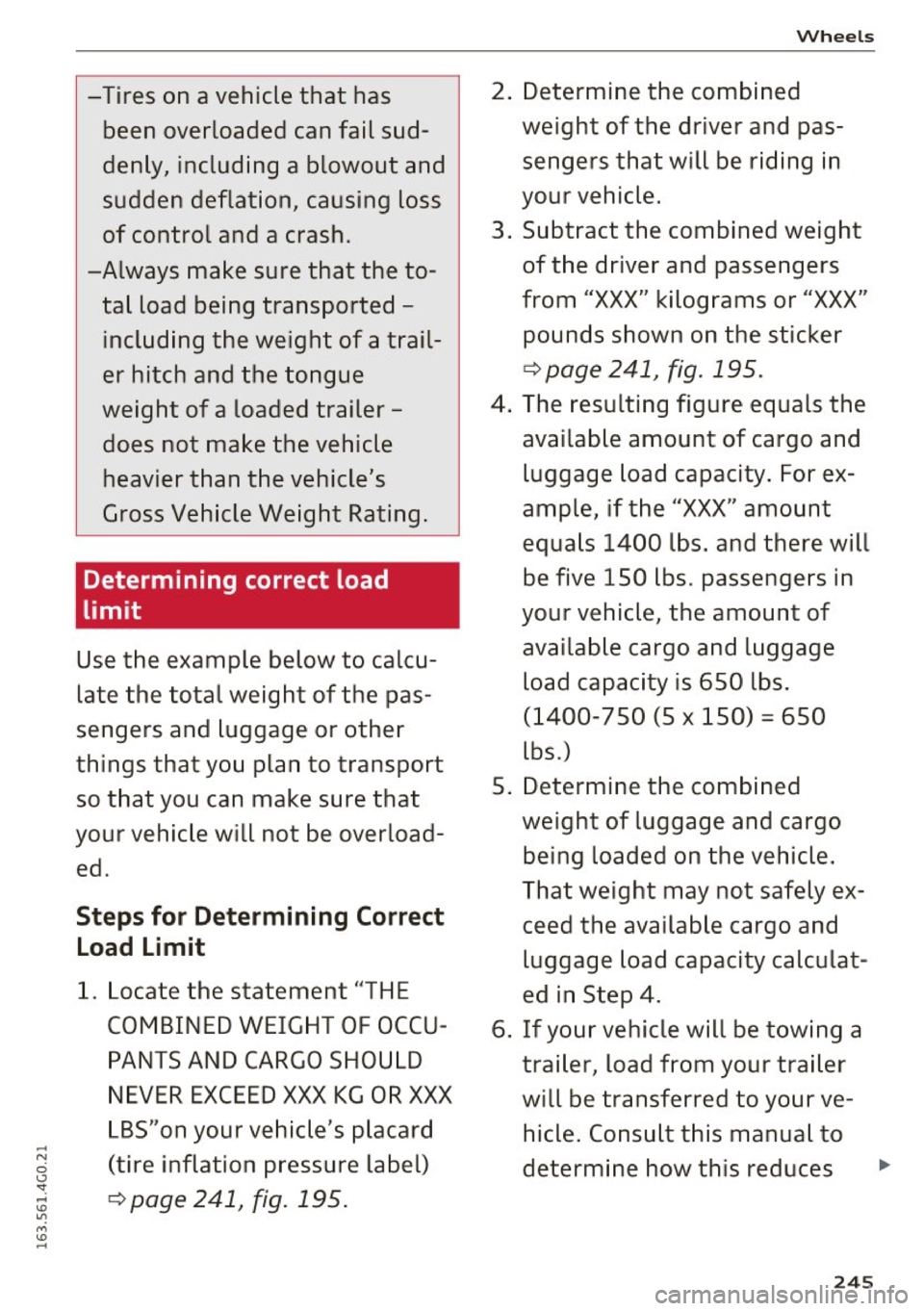
-Tires on a vehicle that has
been overloaded can fail sud
denly, including a blowout and
sudden deflation, causing loss
of control and a crash.
-Always make sure that the to tal load being transported -
including the weight of a trail
er hitch and the tongue
weight of a loaded trailer - does not make the vehicle
heavier than the vehicle's
Gross Vehicle Weight Rating.
Determining correct load
limit
Use the example below to calcu
late the total weight of the pas
sengers and luggage or other
things that you plan to transport so that you can make sure that
your vehicle will not be overload
ed.
Steps for Determining Correct Load Limit
1. Locate the statement "THE
COMBINED WEIGHT OF OCCU
PANTS AND CARGO SHOULD
NEVER EXCEED XXX KG OR XXX
LBS "on your vehicle's placard
(tire inflation pressure label)
¢ page 241, fig. 195.
Wheels
2. Determine the combined
weight of the driver and pas sengers that will be riding in
your vehicle.
3. Subtract the combined weight of the driver and passengers
from "XXX" kilograms or "XXX"
pounds shown on the sticker
¢ page 241, fig . 195 .
4. The resulting figure equals the
available amount of cargo and
luggage load capacity. For ex
ample, if the "XXX " amount
equals
1400 lbs. and there will
be five
150 lbs . passengers in
your vehicle, the amount of
available cargo and luggage
load capacity is 650 lbs.
(1400-750 (5 X 150) = 650
lbs .)
5. Determine the combined
weight of luggage and cargo
being loaded on the vehicle.
That weight may not safely ex ceed the available cargo and
luggage load capacity calculat
ed in Step 4.
6. If your vehicle will be towing a trailer, load from your trailer
will be transferred to your ve
hicle. Consult this manual to
determine how this reduces ..,
245
Page 255 of 294
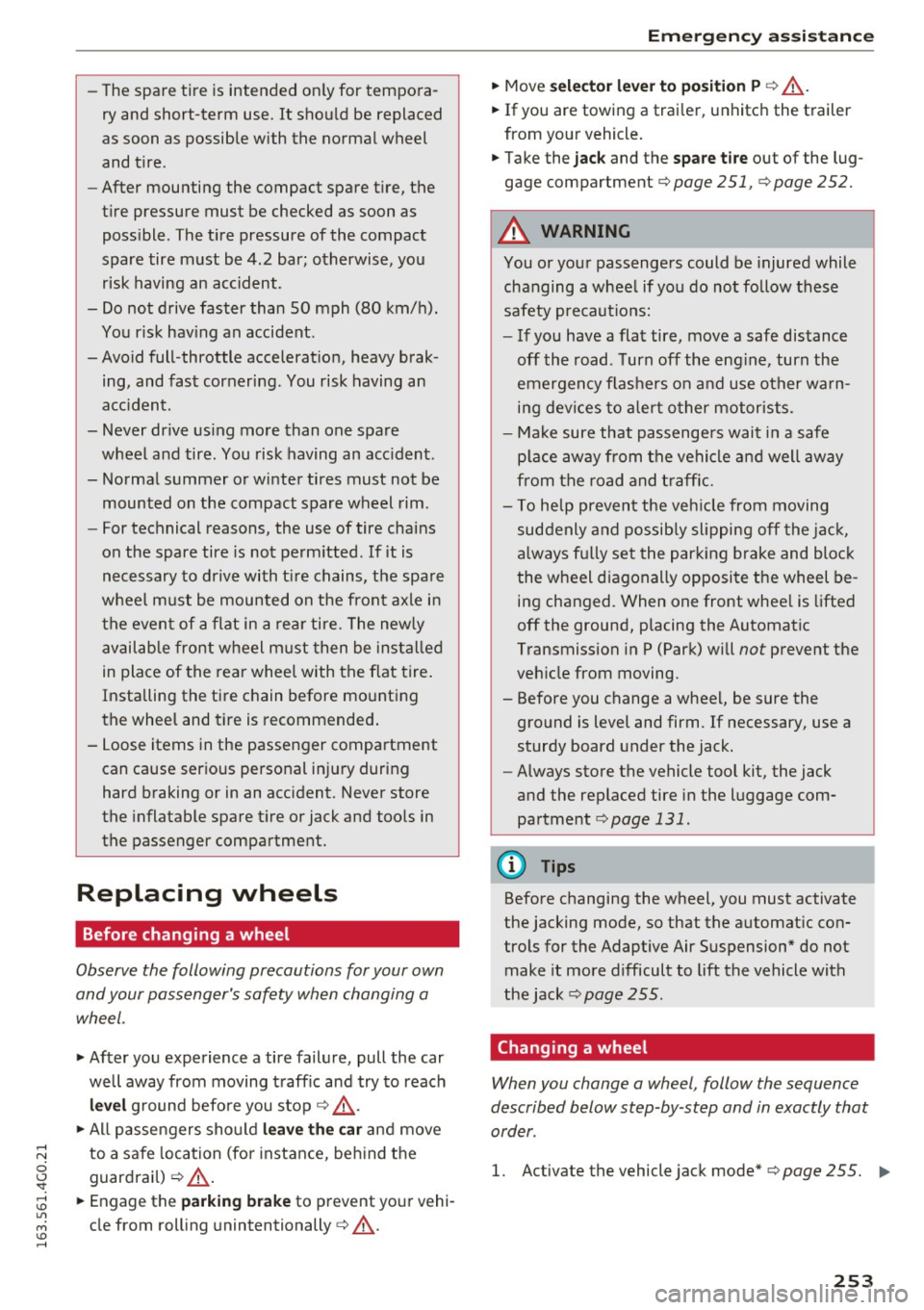
-The spare tire is intended on ly for tempora
ry and short-term use. It shou ld be replaced
as soon as possible with the normal wheel
and t ire.
- After mounting the compact spare tire, the
tire pressure must be checked as soon as
poss ible. The t ire pressure of the compact
spare tire m ust be 4.2 bar; otherwise, you
risk having an accident.
- Do not drive faster than SO mph (80 km/h).
You risk hav ing an accident .
-Avoid full-throttle accelerat ion, heavy brak
ing, and fast cornering . You risk having an
acc ident.
- Never drive us ing more than one spare
wheel and tire . You risk having an acc ident.
- Normal summer or winter tires must not be
mounted on the compact spare wheel rim .
- For technical reasons, the use of tire chains
on the spare tire is not perm itted. If it is
necessary to drive with t ire chains, the spare
wheel m ust be mounted on the front axle i n
the even t of a flat in a rea r tire. The new ly
avail able front wheel m ust then be insta lled
in place of the rear wheel with the flat tire .
Installing the tire chain before mounting
the wheel and tire is recommended .
- Loose items in the passenger compartment
can cause ser ious personal injury during
hard braking or in an acc ident. Never store
the inflatable spare t ire or jack and too ls in
the passenger compartment.
Replacing wheels
Before changing a wheel
Observe the following precautions for your own
and your passenger's safety when changing a
wheel.
• After you experience a tire failure , pull the car
well away from moving t raff ic and try to reach
level ground before you stop¢ A-
• All passengers sho uld leave the car and move
to a safe location (fo r instance, be hind the
guardrail) ¢
A.
• Engage the parking b rake to prevent yo ur vehi
cle from roll ing unintentionally ¢
A-
Em ergenc y ass is tanc e
• Move selecto r lever t o po sit ion P ¢ A .
• If you are towing a trai ler, unhitch the trailer
from yo ur vehicle .
• Take the
jack and the spare tire out of the lug
gage compartment
¢page 251, ¢page 252.
A WARNING
You or your passengers could be injured while
changing a whee l if you do no t follow these
safety precaut ions:
- If you have a flat tire, move a safe distance
off the road. Turn off the eng ine, turn the
emergency f lashers on a nd use other wa rn
ing devices to alert other motorists.
- Make sure that passenge rs wait i n a safe
p la ce away from the vehicle and well away
fr om the road and t raff ic.
- To help preven t the veh icle from moving
suddenly and possib ly slipping off the ja ck,
always fu lly set the park ing brake and bloc k
the wheel diagonally opposite the wheel be ing changed. When one front whee l is lifted
off the ground, placing the Automatic
Transmission in P (Park) wi ll
not prevent the
veh icle from moving.
- Before you change a wheel, be sure the
ground is level and firm. If necessary, use a
sturdy board under the jack.
- Always store the vehicle tool kit, the jack
and the replaced tire in the luggage com
partment
¢ page 131.
(!) Tips
Before changing the wheel, you must activate
the jacking mode, so that the automat ic con
tro ls for the Adaptive Air Suspension* do not
make it more difficult to lift the vehicle with
the jack ¢
page 255.
Changing a wheel
When you change a wheel , follow the sequence
described below step -by -step and in exactly that
order .
l. Activate the vehicle jack mode*¢ page 255. .,.
253
Page 286 of 294
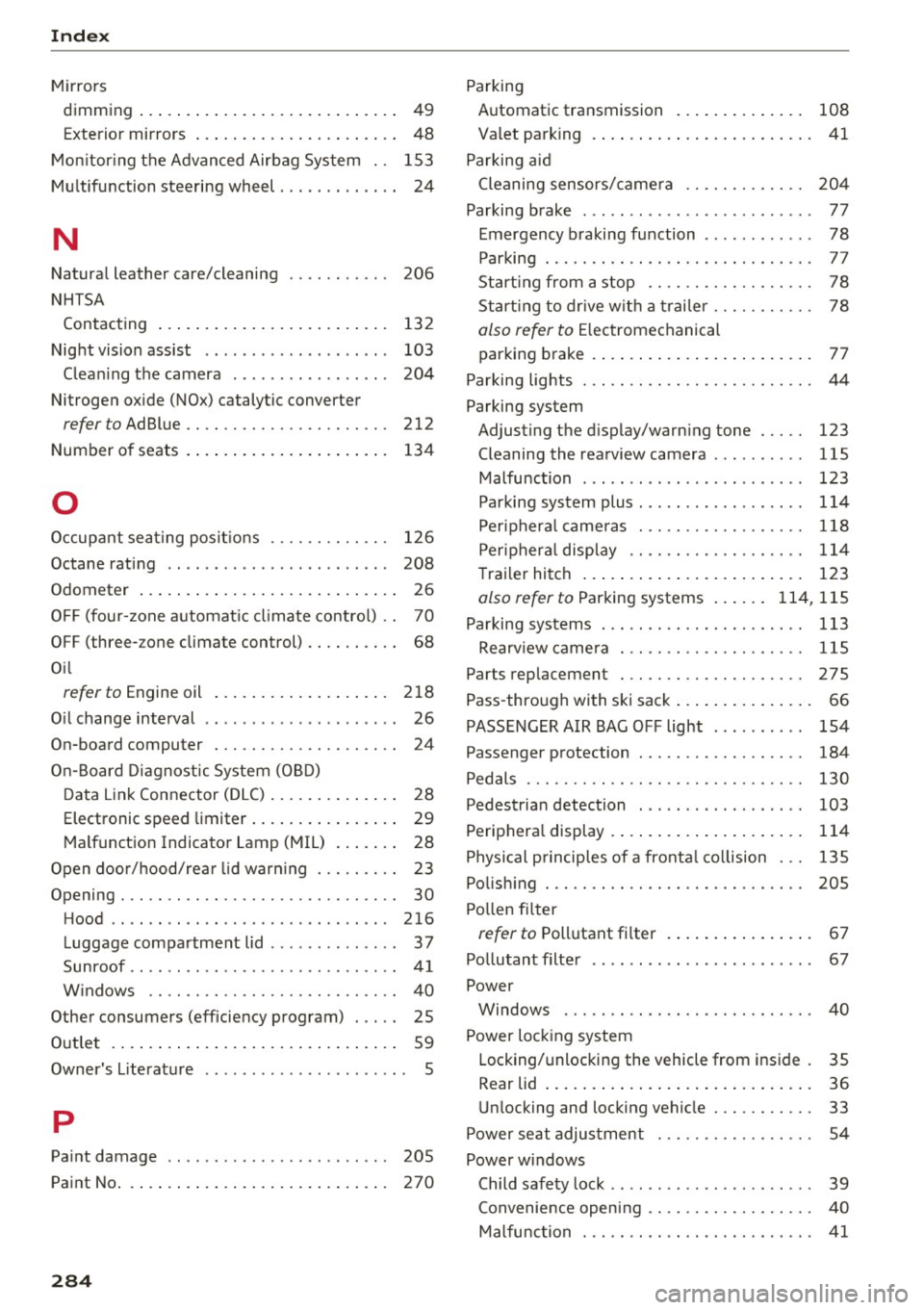
Index
Mirrors dimming ... .... ................ ..... 49
Exterior mirrors . . . . . . . . . . . . . . . . . . . . . . 48
Mon itor ing the Advanced Airbag System . . 153
Multifunction steering wheel . . . . . . . . . . . . . 24
N
Natural leather care/cleaning
NHTSA 206
Contacting . . . . . . . . . . . . . . . . . . . . . . . . . 132
Night vision assist . . . . . . . . . . . . . . . . . . . . 103
Cleaning the camera . . . . . . . . . . . . . . . . . 204
Nitrogen oxide (NOx) catalytic converter
refer to AdBlue .... .................. 212
Number of seats . . . . . . . . . . . . . . . . . . . . . . 134
0
Occupant seating positions . . . . . . . . . . . . . 126
Octane rating . . . . . . . . . . . . . . . . . . . . . . . . 208
Odometer . . . . . . . . . . . . . . . . . . . . . . . . . . . . 26
OFF (four-zone automat ic cl imate control) . . 70
OFF (three- zone climate control) . . . . . . . . . . 68
Oil
refer to Engine oil . . . . . . . . . . . . . . . . . . . 218
Oil change interval . . . . . . . . . . . . . . . . . . . . . 26
On-board computer . . . . . . . . . . . . . . . . . . . . 24
On-Board Diagnostic System (OBD)
Data Link Connector (DLC) . . . . . . . . . . . . . . 28
Electronic speed limiter . . . . . . . . . . . . . . . . 29
Malfunction Indicator Lamp (MIL) . . . . . . . 28
Open door/hood/rear lid warn ing . . . . . . . . . 23
Opening..... .. .. ..................... 30
Hood . . . . . . . . . . . . . . . . . . . . . . . . . . . . . . 216
Luggage compartment lid . . . . . . . . . . . . . . 37
Sunroof .. .. .. .. ............. .. .. .. .. 41
W indows .. .. .... ............. ...... 40
Other consumers (efficiency program) . . . . . 25
Outlet . . . . . . . . . . . . . . . . . . . . . . . . . . . . . . . 59
Owner 's Literature
5
p
Paint damage 205
Paint No. . . . . . . . . . . . . . . . . . . . . . . . . . . . . 270
284
Parking
Automatic transmission . . . . . . . . . . . . . . 108
Valet parking . . . . . . . . . . . . . . . . . . . . . . . . 41
Parking aid Cleaning sensors/camera . . . . . . . . . . . . . 204
Parking brake . . . . . . . . . . . . . . . . . . . . . . . . . 77
Emergency braking function . . . . . . . . . . . . 78
Parking . . . . . . . . . . . . . . . . . . . . . . . . . . . . . 77
Start ing from a stop . . . . . . . . . . . . . . . . . . 78
Start ing to drive w ith a trailer . . . . . . . . . . . 78
also refer to Electromechanical
parking brake . . . . . . . . . . . . . . . . . . . . . . . . 77
Parking lights . . . . . . . . . . . . . . . . . . . . . . . . . 44
Parking system Adjusting the display/warning tone . . . . . 123 Cleaning the rearview camera . . . . . . . . . . 115
Malfunction . . . . . . . . . . . . . . . . . . . . . . . . 123
Parking system plus . . . . . . . . . . . . . . . . . . 114
Peripheral cameras . .. ............. .. 118
Peripheral display . . . . . . . . . . . . . . . . . . . 114
Trailer hitch . . . . . . . . . . . . . . . . . . . . . . . . 123
also refer to Parking systems . . . . . . 114, 115
Parking systems . . . . . . . . . . . . . . . . . . . . . . 113
Rearv iewcamera ..... ............... 115
Parts replacement . . . . . . . . . . . . . . . . . . . . 275
Pass-through with ski sack . . . . . . . . . . . . . . . 66
PASSENGER AIR BAG OFF light . . . . . . . . . . 154
Passenger protection . . . . . . . . . . . . . . . . . . 184
Pedals . . . . . . . . . . . . . . . . . . . . . . . . . . . . . . 130
Pedestrian detection . . . . . . . . . . . . . . . . . . 103
Peripheral display. ... ................. 114
Physical principles of a frontal co llision . . . 135
Polishing . . . . . . . . . . . . . . . . . . . . . . . . . . . . 205
Po llen filter
refer to Pollutant filter . . . . . . . . . . . . . . . . 67
Pollutant filter . . . . . . . . . . . . . . . . . . . . . . . . 67
Power Windows . .... .. .. .. ............. ... 40
Power locking system Locking/unlocking the vehicle from inside . 35
Rear lid . . . . . . . . . . . . . . . . . . . . . . . . . . . . . 36
Unlocking and locking vehicle . . . . . . . . . . . 33
Power seat adjustment . . . . . . . . . . . . . . . . . 54
Power windows Child safety lock . . . . . . . . . . . . . . . . . . . . . . 39
Convenience opening . . . . . . . . . . . . . . . . . . 40
Malfunction . . . . . . . . . . . . . . . . . . . . . . . . . 41
Page 289 of 294
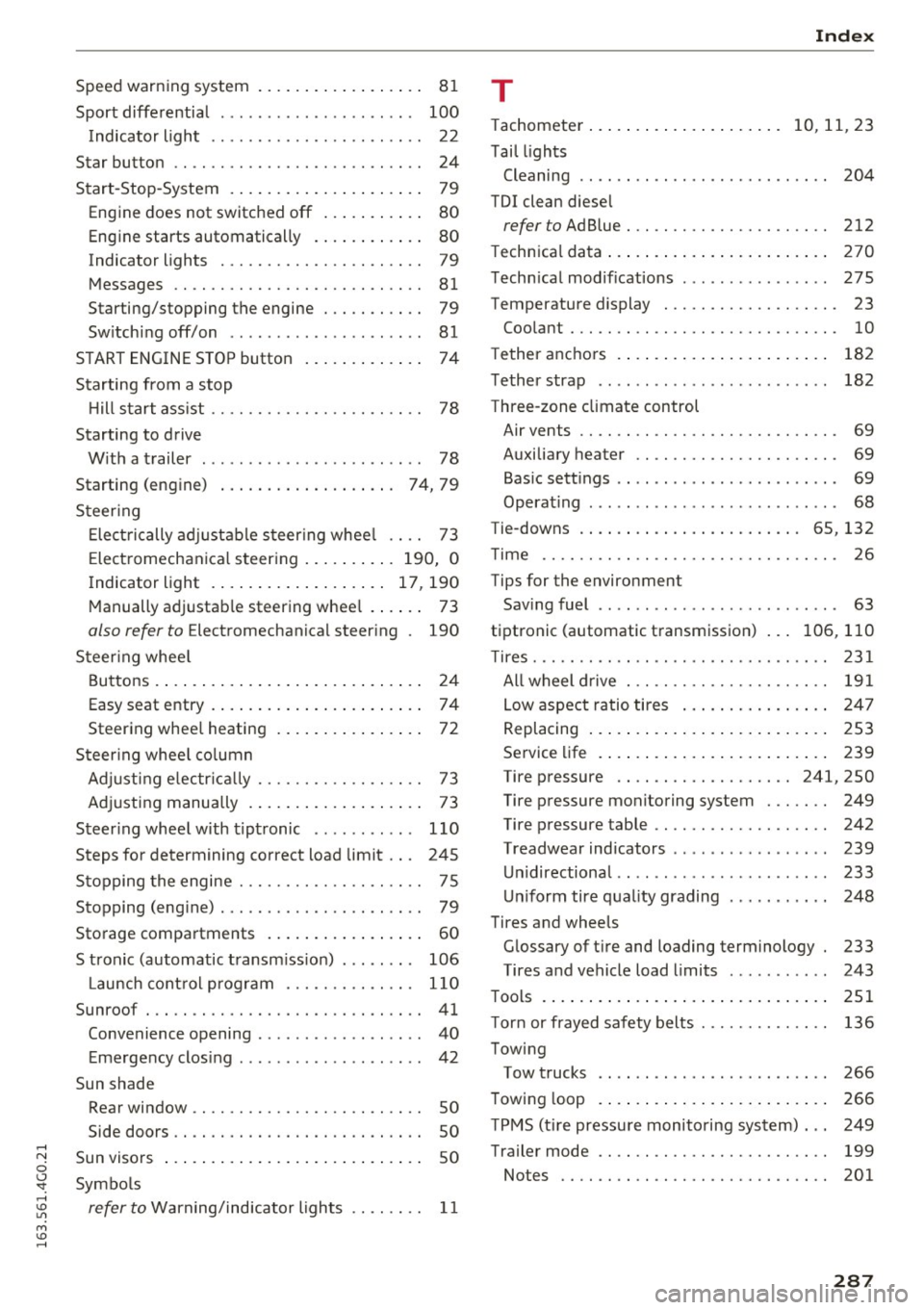
....
Speed warning system . . . . . . . . . . . . . . . . . . 81
Sport differential . . . . . . . . . . . . . . . . . . . . . 100
Indicator light . . . . . . . . . . . . . . . . . . . . . . . 22
Star button . . . . . . . . . . . . . . . . . . . . . . . . . . . 24
Start-Stop-System . . . . . . . . . . . . . . . . . . . . . 79
Engine does not switched off . . . . . . . . . . . 80
Engine starts automatically . . . . . . . . . . . . 80
Indicator lights . . . . . . . . . . . . . . . . . . . . . . 79
Messages . . . . . . . . . . . . . . . . . . . . . . . . . . . 81
Starting/stopping the engine . . . . . . . . . . . 79
Switching off/on . . . . . . . . . . . . . . . . . . . . . 81
START ENGINE STOP button . . . . . . . . . . . . . 74
Starting from a stop
H ill start assist . . . . . . . . . . . . . . . . . . . . . . . 78
Starting to drive W ith a trailer . . . . . . . . . . . . . . . . . . . . . . . . 78
Starting (engine) . . . . . . . . . . . . . . . . . . . 74, 79
Steering Electrically adjustable steering wheel . . . . 73
Electromechanical steering .......... 190, 0
Indicator light ................ ... 17, 190
Manually adjustable steering wheel . . . . . . 73
also refer to Electromechanical steering . 190
Steer ing wheel
Buttons....................... .... .. 24
Easy seat entry . . . . . . . . . . . . . . . . . . . . . . . 7 4
Steering wheel heating . . . . . . . . . . . . . . . . 72
Steering wheel column
Adj usting electr ically . . . . . . . . . . . . . . . . . . 73
Adjusting manually . . . . . . . . . . . . . . . . . . . 73
Steering wheel with tiptronic . . . . . . . . . . . 110
Steps for determining correct load limit . . . 245
Stopping the engine . . . . . . . . . . . . . . . . . . . . 75
Stopping (engine) . . . . . . . . . . . . . . . . . . . . . . 79
Storage compartments . . . . . . . . . . . . . . . . . 60
S tronic (automatic transmission) . . . . . . . . 106
L aunch control program . . . . . . . . . . . . . . 110
Sunroof . . . . . . . . . . . . . . . . . . . . . . . . . . . . . . 41
Convenience opening . . . . . . . . . . . . . . . . . . 40
Emergency closing . . . . . . . . . . . . . . . . . . . . 42
Sun shade Rear window . . . . . . . . . . . . . . . . . . . . . . . . . 50
Side doors . . . . . . . . . . . . . . . . . . . . . . . . . . . 50
~ Sun visors . . . . . . . . . . . . . . . . . . . . . . . . . . . . 50
~ Symbols ....
~ refer to Warning/indicator lights . . . . . . . . 11
M v:, ....
Index
T
Tachomete r . . . . . . . . . . . . . . . . . . . . . 10 , 11, 23
Tail lights Cleaning . . . . . . . . . . . . . . . . . . . . . . . . . . . 204
TOI clean diesel
refer to Ad Blue. .... ............... .. 212
Technical data . . . . . . . . . . . . . . . . . . . . . . . . 270
Technical modifications . . . . . . . . . . . . . . . . 275
T emperature display . . . . . . . . . . . . . . . . . . . 23
Coolant . . . . . . . . . . . . . . . . . . . . . . . . . . . . . 10
Tether anchors . . . . . . . . . . . . . . . . . . . . . . . 182
Tether strap . . . . . . . . . . . . . . . . . . . . . . . . . 182
Three-zone climate control Air vents . . . . . . . . . . . . . . . . . . . . . . . . . . . . 69
Auxiliary heater . . . . . . . . . . . . . . . . . . . . . . 69
Basic settings . . . . . . . . . . . . . . . . . . . . . . . . 69
Operating . . . . . . . . . . . . . . . . . . . . . . . . . . . 68
Tie-downs . . . . . . . . . . . . . . . . . . . . . . . . 65, 132
T ime ...... .... .. .. ............... .. . 26
Tips for the environmen t
Saving fuel . . . . . . . . . . . . . . . . . . . . . . . . . . 63
tiptronic (automatic transmission) ... 106, 110
T ires....... .. .. .. .. ............... .. 231
All wheel drive . . . . . . . . . . . . . . . . . . . . . . 191
Low aspect ratio tires . . . . . . . . . . . . . . . . 247
Replacing . . . . . . . . . . . . . . . . . . . . . . . . . . 253
Service life . . . . . . . . . . . . . . . . . . . . . . . . . 239
Tire pressure . . . . . . . . . . . . . . . . . . . 241, 250
Tire pressure monitoring system . . . . . . . 249
Tire pressure table . . . . . . . . . . . . . . . . . . . 242
T readwear indicators . . . . . . . . . . . . . . . . . 239
Unidirectional . . . . . . . . . . . . . . . . . . . . . . . 233
Uniform tire quality grading . . . . . . . . . . . 248
Tires and wheels Glossary of tire and loading terminology . 233
Tires and vehicle load limits . . . . . . . . . . . 243
Tools . . . . . . . . . . . . . . . . . . . . . . . . . . . . . . . 251
Torn or frayed safety belts . . . . . . . . . . . . . . 136
Towing Tow trucks . . . . . . . . . . . . . . . . . . . . . . . . . 266
Towing loop . . . . . . . . . . . . . . . . . . . . . . . . . 266
TPMS (tire pressure monitoring system) . . . 249
Trailer mode . . . . . . . . . . . . . . . . . . . . . . . . . 199
Notes . . . . . . . . . . . . . . . . . . . . . . . . . . . . . 201
287